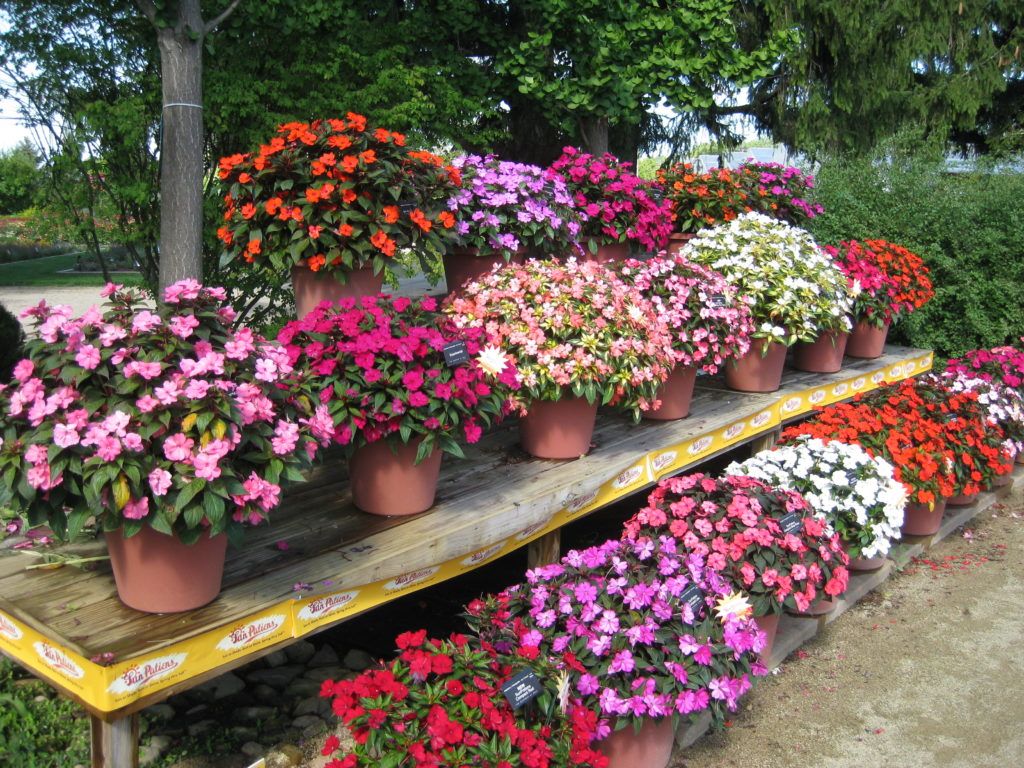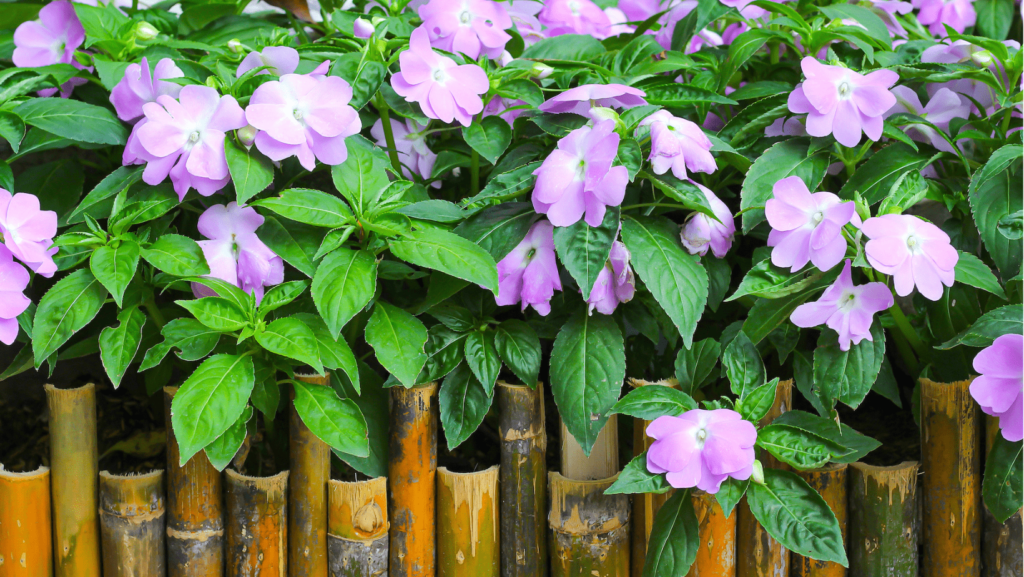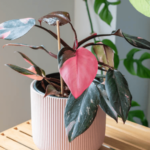Impatiens beautiful flowers can thrive indoors, but many home gardeners unknowingly waste their efforts. From overwatering to neglecting pest control, the path to lush, healthy impatiens is fraught with potential missteps. But With the right knowledge, you can avoid these common mistakes and create a stunning indoor impatiens flowers display.
Understanding Impatiens’ Indoor Needs
1-Providing Adequate Light to Impatiens
Impatiens prefer bright, indirect light when grown indoors. Avoid placing them in direct sunlight, as this can scorch their delicate leaves. Position your plants near a north or east-facing window for optimal light exposure.
Choosing the Right Potting Mix for Impatiens
The ideal potting mix for impatiens should be well-draining yet moisture-retentive. A combination of peat moss, perlite, and vermiculite works well. Here’s a simple recipe:
| Component | Proportion |
|---|---|
| Peat moss | 2 parts |
| Perlite | 1 part |
| Vermiculite | 1 part |
This mix provides the perfect balance of drainage and moisture retention for healthy impatiens growth.
Ensuring Appropriate Humidity Levels for Impatiens

To maintain proper humidity:
- Use a pebble tray filled with water beneath the plant
- Group plants together to create a microclimate
- Mist the leaves regularly, especially during dry winter months
RELATED BLOG
- 7-Tricks to Prune,Propagate and Fertilize Incrediball Hydrangea Plant
4 Best Hydrangea for Front of House
Temperature Requirement for Impatiens
Impatiens prefer moderate temperatures between 65°F and 75°F (18°C to 24°C). Protect them from cold drafts and sudden temperature fluctuations. In winter, keep them away from chilly windows to prevent leaf drop and stunted growth.
By carefully managing these four key aspects of impatiens care, you’ll create an ideal indoor environment for your plants to flourish.
2-Watering Requirements for Impatiens
When it comes to growing impatiens indoors, proper watering is crucial for their health and vitality. Let’s explore some common watering mistakes and how to avoid them.
A. Using proper drainage techniques
Ensuring adequate drainage is essential for impatiens to thrive. Poor drainage can lead to root rot and other water-related issues.
- Use pots with drainage holes
- Add a layer of gravel or pebbles at the bottom of the container
- Mix perlite or vermiculite into the potting soil for improved aeration
B. Establishing a consistent watering schedule
Impatiens prefer consistently moist soil, but finding the right balance is key.
| Frequency | Amount | Method |
|---|---|---|
| 2-3 times per week | Enough to moisten the soil | Water at the base of the plant |
Adjust this schedule based on your specific indoor conditions and the plant’s needs.
C. Underwatering consequences
Underwatering can be detrimental to impatiens. Watch out for these signs of water stress:
- Wilting leaves
- Drooping stems
- Slow growth
- Leaf drop
To prevent underwatering, check the soil moisture regularly and water when the top inch feels dry.
D. Overwatering risks
While impatiens love moisture, overwatering can be just as harmful as underwatering. Be aware of these overwatering symptoms:
- Yellowing leaves
- Soft, mushy stems
- Mold growth on soil surface
- Fungus gnats
To avoid overwatering, always check the soil moisture before watering and ensure proper drainage.
By avoiding these common watering pitfalls, you’ll be well on your way to growing healthy, vibrant impatiens indoors.
3-Impatiens Fertilization
Proper fertilization is essential for healthy growth and vibrant blooms, but it’s easy to make mistakes that can harm your plants.
Timing fertilization correctly
Timing is everything when it comes to fertilizing impatiens. These colorful bloomers have specific needs throughout their growth cycle:
- Spring: Begin fertilizing when new growth appears
- Summer: Maintain regular feeding schedule
- Fall: Gradually reduce fertilization
- Winter: Pause feeding during dormancy
Selecting the right fertilizer
Choosing the appropriate fertilizer is crucial for impatiens’ health. Here’s a comparison of suitable options:
| Fertilizer Type | NPK Ratio | Benefits | Considerations |
|---|---|---|---|
| Balanced liquid | 10-10-10 | Easy to apply, quick absorption | Requires frequent application |
| Slow-release granules | 14-14-14 | Long-lasting, less frequent application | Initial cost may be higher |
| Organic options | Varies | Improves soil health, environmentally friendly | May have slower results |
Under-fertilizing effects
Failing to provide adequate nutrients can lead to:
- Pale or yellowing leaves
- Stunted growth
- Reduced flower production
- Increased susceptibility to pests and diseases
Over-fertilizing dangers
On the flip side, excessive fertilization can be equally harmful:
- Leaf burn or browning
- Root damage
- Salt buildup in the soil
- Excessive foliage growth at the expense of flowers
To avoid these issues, always follow the recommended dosage on the fertilizer package and adjust based on your impatiens’ response. Regular soil testing can help you maintain the perfect balance for your indoor impatiens to thrive.

4-Common Pest and Disease in Impatiens
When growing impatiens indoors, it’s crucial to be vigilant about pests and diseases. Many gardeners make common mistakes that can lead to significant problems.
A. Using incorrect treatments
One of the most frequent errors is applying the wrong treatment to combat pests or diseases. This can be ineffective at best and harmful to your impatiens at worst. Always identify the specific issue before treating:
| Problem | Correct Treatment | Incorrect Treatment |
|---|---|---|
| Aphids | Insecticidal soap or neem oil | Fungicides |
| Powdery mildew | Fungicide specific for mildew | General purpose pesticide |
| Spider mites | Miticide or insecticidal soap | Overwatering |
B. Failing to quarantine new plants
Introducing new plants without quarantine is a recipe for disaster. Always isolate new impatiens for at least two weeks to prevent potential pest or disease spread:
- Keep new plants in a separate room
- Observe for signs of pests or diseases
- Treat any issues before introducing to other plants
C. Neglecting preventive measures
Prevention is key in maintaining healthy impatiens. Many gardeners overlook simple preventive steps:
- Ensure proper air circulation
- Clean tools between plants
- Remove dead or diseased foliage promptly
- Use sterile potting soil
D. Ignoring early signs of infestation
Early detection is crucial for effective pest and disease management. Be on the lookout for:
- Discolored or distorted leaves
- Sticky residue on leaves (honeydew from pests)
- Webbing between leaves (spider mites)
- White, powdery substance on leaves (powdery mildew)

5-Impatiens Pruning and Maintenance Mistakes
When it comes to growing impatiens indoors, proper pruning and maintenance are crucial for their health and appearance.
A. Ignoring overall plant shape
One of the biggest mistakes is neglecting the overall shape of your impatiens. A well-shaped plant not only looks better but also promotes healthier growth. To maintain an attractive shape:
- Regularly observe your plant from different angles
- Remove any branches that disrupt the plant’s natural form
- Encourage balanced growth by pruning evenly around the plant
B. Neglecting to pinch back for bushier growth
Pinching back is essential for promoting bushier, fuller impatiens. Many gardeners overlook this simple technique, resulting in leggy plants.
- Pinch off the growing tips of young plants when they reach 4-6 inches tall
- Continue pinching throughout the growing season
- Use clean, sharp scissors or your fingertips to remove the top 1-2 inches of stem
C. Improper deadheading techniques
Deadheading is crucial for maintaining continuous blooms, but improper techniques can harm your impatiens. Avoid these common errors:
| Mistake | Correct Technique |
|---|---|
| Pulling off spent blooms | Cut cleanly with scissors |
| Removing only the flower | Cut back to the nearest leaf node |
| Infrequent deadheading | Remove spent blooms regularly |
D. Overlooking regular pruning
Regular pruning is often overlooked but is vital for maintaining healthy impatiens. It helps:
- Improve air circulation
- Reduce disease risk
- Encourage new growth
Aim to prune your impatiens every 4-6 weeks during the growing season, removing up to 1/3 of the plant’s growth.
6-Container and Space Selection Mistakes for Impatiens
When growing impatiens indoors, avoiding container and space selection mistakes is crucial for their health and growth.
A. Placing plants in unsuitable locations
Impatiens thrive in specific light conditions. Here’s a quick guide to help you choose the right spot:
| Light Condition | Suitable for Impatiens? |
|---|---|
| Direct sunlight | No |
| Bright, indirect light | Yes |
| Low light | Some varieties |
| Complete shade | No |
Choose a location with bright, indirect light for most impatiens varieties. Avoid windowsills with intense afternoon sun, as this can scorch the leaves.
B. Neglecting to repot when necessary
Impatiens grow quickly and may outgrow their containers. Signs it’s time to repot include:
- Roots growing out of drainage holes
- Stunted growth
- Frequent wilting despite proper watering
Repot your impatiens every 12-18 months or when you notice these signs.
C. Underestimating space requirements
Impatiens need room to spread their foliage and develop a robust root system. Consider these points:
- Allow 8-12 inches between plants
- Choose containers at least 6 inches deep
- Provide 1-2 inches of space between the soil surface and pot rim
D. Choosing pots without proper drainage
Proper drainage is essential for impatiens to prevent root rot. When selecting containers:
- Ensure they have drainage holes
- Use a well-draining potting mix
- Consider adding a layer of pebbles at the bottom for extra drainage
7-Impatiens Propagation Mistakes
When propagating impatiens, it’s essential to avoid common mistakes that can hinder successful growth.
A. Transplanting too early or too late
Timing is crucial when transplanting impatiens cuttings. Transplanting too early can shock the delicate roots, while waiting too long may lead to stunted growth. Here’s a guide to help you get it right:
| Stage | Ideal Transplanting Time |
|---|---|
| Seedlings | When they have 2-3 true leaves |
| Cuttings | 2-3 weeks after rooting |
B. Failing to provide proper rooting conditions
Impatiens cuttings require specific conditions to root successfully:
- Maintain high humidity (70-80%)
- Keep soil temperature between 70-75°F (21-24°C)
- Use a well-draining rooting medium
- Provide indirect, bright light
C. Incorrect cutting techniques
Proper cutting techniques are vital for successful propagation:
- Use clean, sharp tools to prevent disease transmission
- Make cuts just below a leaf node at a 45-degree angle
- Remove lower leaves, leaving only 2-3 pairs at the top
- Dip the cut end in rooting hormone for better success
D. Using unhealthy parent plants
The health of the parent plant directly impacts the success of propagation. Avoid using:
- Plants with signs of disease or pest infestation
- Stressed or weak plants
- Flowering stems (use vegetative growth instead)
By avoiding these common propagation errors, you’ll significantly increase your chances of successfully growing healthy impatiens indoors. With proper care and attention to detail, you’ll soon have a thriving collection of these beautiful, shade-loving plants.
Growing impatiens indoors can be a rewarding experience, but it requires careful attention to avoid common mistakes. By understanding their specific needs, you can create an optimal environment for these vibrant plants to thrive. Proper watering, balanced fertilization, and vigilant pest management are crucial for their health and longevity. Additionally, regular pruning, selecting the right container and space, and using correct propagation techniques will ensure your impatiens flourish indoors.
FAQS
Are impatiens deer resistant?
Impatiens are not generally considered deer-resistant. While they might not be a top choice for deer, they can still be susceptible to grazing, especially during times of food scarcity.
Are impatiens poisonous to dogs?
Yes, impatiens can be poisonous to dogs. While not as toxic as some other plants, ingesting impatiens can cause gastrointestinal upset in dogs, including vomiting and diarrhea.
If you suspect your dog has eaten impatiens, it’s important to contact your veterinarian immediately. They can provide advice on whether your dog needs medical attention.







